[ad_1]
Zoom is rich with features, many of which you may have never heard about. No matter how long you’ve been using the video conferencing app, there are a number of helpful and fun tips, tricks and hidden features you can find to upgrade your video chatting experience. Here are 20 ways to become a Zoom master.
Read more: Ultimate Webcam Tips: How to Look and Sound Great Online
1. Change your background
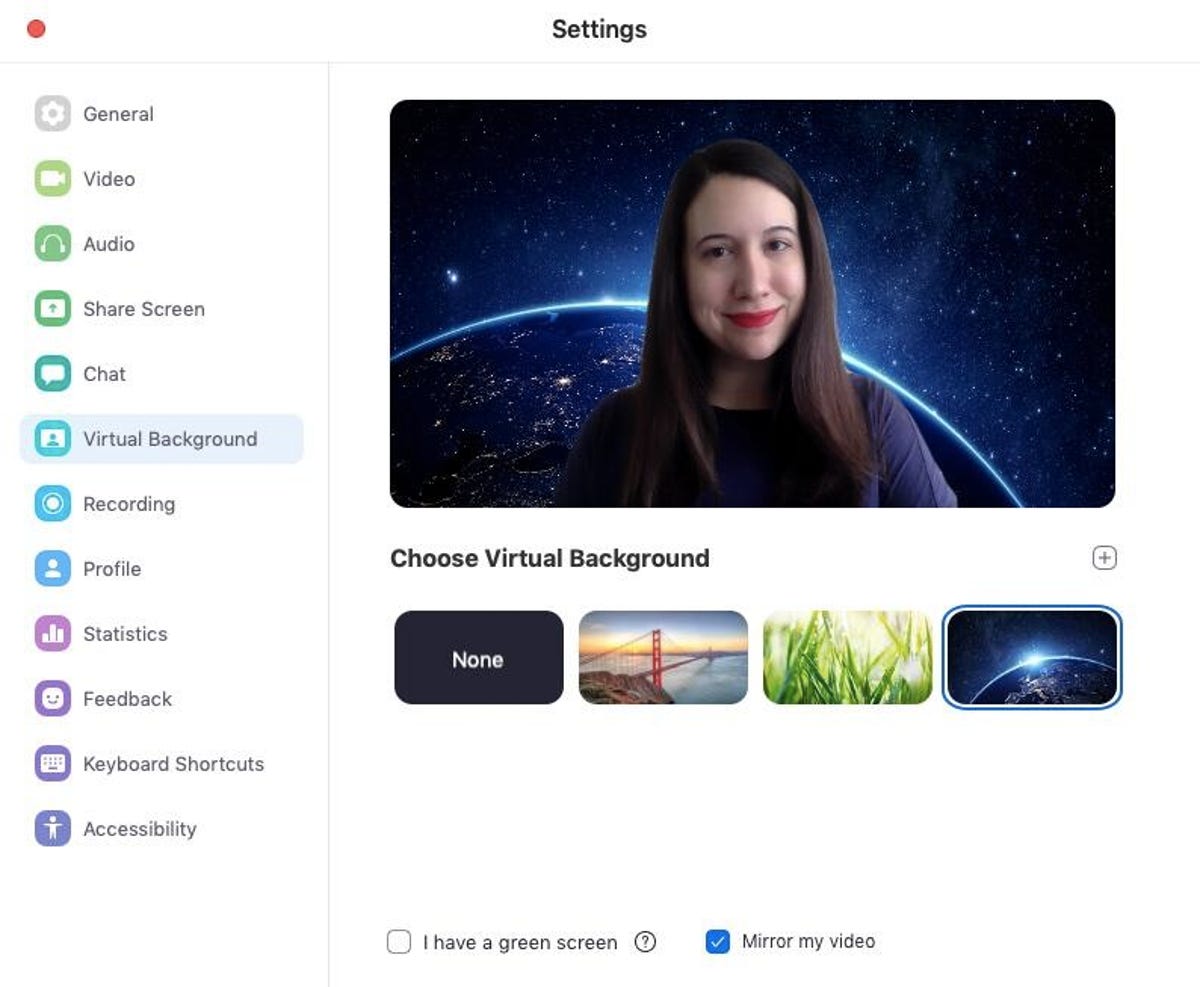
Change your Zoom background to space, or a custom photo.

Virtually transport yourself to the beach, outer space or anywhere else you can imagine by customizing your Zoom background. You can read our step-by-step guide to changing your Zoom background on the desktop and mobile app, but basically you go to Settings > Virtual Background and select or upload the image you want from there. However, you do have to make sure that your system meets all of the requirements to do so.
Read more: 10 free Zoom alternative apps for video chats
2. Change your name on Zoom
There are two ways to change how your name appears in Zoom meetings: Temporary and permanent. If you want to change your name for only the meeting you’re currently in, after you enter the meeting, click the Participants button at the bottom of the screen. Hover over your name, and click More > Rename. Type in the name you want to appear, and click OK.
If you want to change your name for every meeting going forward, go to the Zoom web portal and sign in to your account. Click Profile. In the top right corner across from your name, click Edit. Enter the name you’d like under Display name, and click Save changes. Your new name should appear in every meeting from now on, but you can still change it for individual meetings with the steps above if you’d like.
3. Add your pronouns on Zoom
Adding your pronouns to your name on Zoom is one way to make meetings more inclusive of transgender, gender nonconforming and gender nonbinary people. Including your pronouns can ensure you aren’t assuming anyone’s gender identity based on their appearance, as well as normalizing the use of pronouns in different settings. Similar to changing your name, you can add your pronouns either for every meeting going forward, or just for the meeting you’re currently in. Read the full instructions for adding your pronouns on Zoom.
4. Add a profile picture on Zoom

Zoom lets you change your name and add a profile picture that will appear if your camera is off.
To add a profile picture for an individual meeting, after you enter the meeting, click the Participants button at the bottom of the screen. Hover over your name, and click More > Add profile picture. Select the picture you want from your computer, and click Open.
To add a permanent profile picture to your Zoom meetings, go to theZoom web portal and sign in to your account. Click Profile. In the top right corner across from your name, click Edit. Under the empty photo icon, click Change > Upload. Select the picture you’d like from your computer, and click Open. Readjust which part of the picture you’d like to appear, and click Save.
5. Mute your audio and turn off your camera by default
Diving for the mute audio and camera buttons as soon as you enter a meeting can get old. Keep your coworkers from seeing your bedhead or hearing your cat screeching by turning those off by default. To do it, select Settings > Audio > Mute microphone when joining a meeting, and then Settings > Video > Turn off my video when joining a meeting.
6. Mute and unmute with the space bar
When you are called on to speak, stop scrambling to click the microphone button. You can press and hold the spacebar to quickly mute and unmute your mic, right from your keyboard.
Read more:Zoom, Skype, FaceTime: 11 Tips for Your Video Chat Apps
7. Turn on the beauty filter
Zoom’s Touch Up My Appearance feature aims to smooth over your appearance, making you look dewy and well-rested. If you’ve ever used beauty mode on your phone’s selfie camera, you know what you’re getting.
To turn it on, click the up arrow next to Start Video. Click Video Settings, and under My Video, check the box for Touch Up My Appearance.
8. Set up a waiting room for added privacy
One way to help prevent unwanted guests from crashing your meeting, or Zoombombing, is by enabling the Waiting Room feature, so you can see who’s attempting to join the meeting before allowing them access. To do so, go to Account Management > Account Settings. Click on Meeting, then click Waiting Room to enable the setting. (We’ve got more tips on how to prevent Zoombombing in your meetings here.)
9. Create Zoom breakout rooms for smaller group discussion
Split your big Zoom meeting into up to 100 separate smaller sessions with breakout rooms. To start a breakout room as the host, go to More > Breakout Rooms.
The meeting host can choose to split meeting participants into separate sessions automatically or manually, or can let participants select and enter any breakout session they like. The host can switch between sessions at any point, rename rooms and set time limits for the breakout rooms to close.

Zoom has lots of features to help your meetings run more smoothly.
10. Share your screen
Share your screen for a Zoom meeting (or to watch a movie or play a game) with other participants by clicking the Share screen icon on the toolbar at the bottom of the meeting screen. You’ll have the option to share your entire desktop, or just one of the windows you have open. Click the red Stop Share button at the top of the screen to go back to being a normal participant in the meeting.
11. React with emoji onscreen
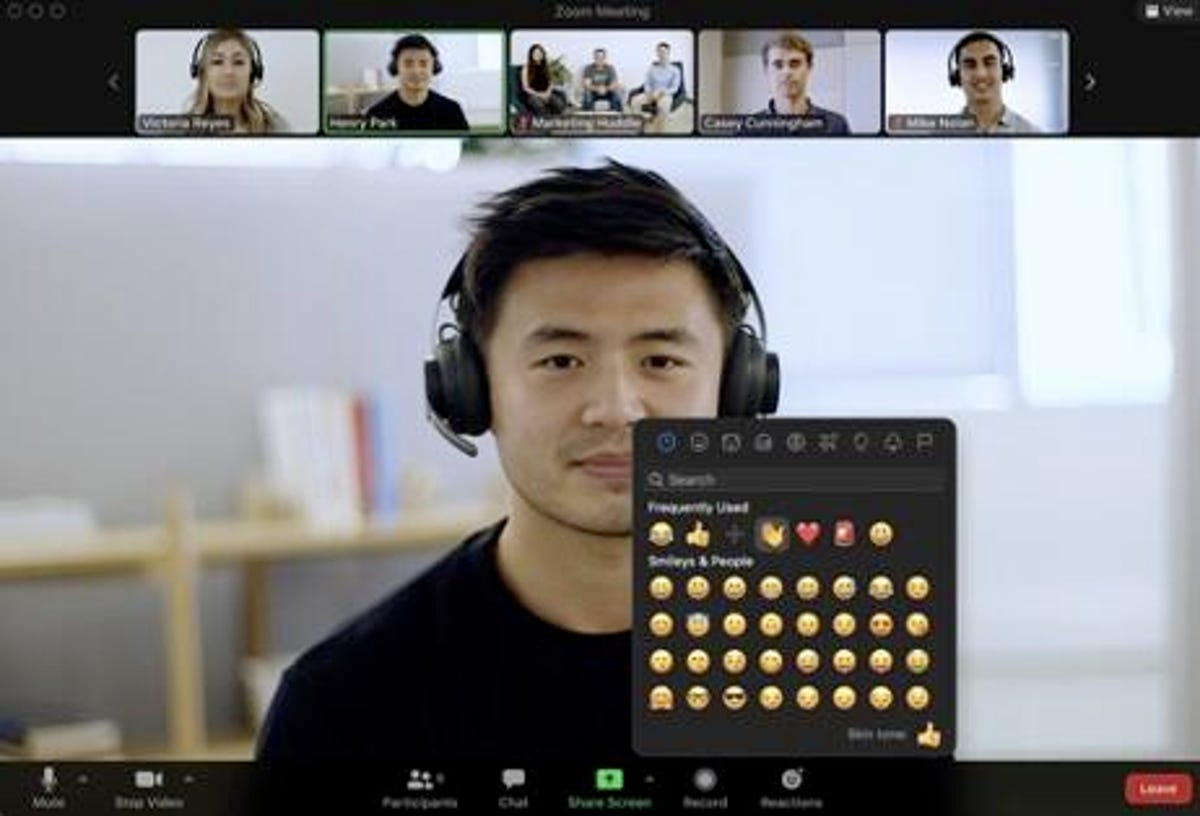
Zoom added a larger set of emoji reactions in an April update.
If you’re muted in a meeting, you can still let others know your thoughts with emoji reactions. Send a thumbs-up, a clapping emoji or dozens of other options to communicate without interrupting the meeting.
To react during a meeting, click the Reactions tab at the bottom of the meeting screen (it’s in the same panel as mute audio and video, to the right) and choose the one you want. The emoji will disappear after 10 seconds.
If the meeting organizer enables the nonverbal feedback feature, participants can choose the Raise Hand emoji option and wait to be recognized. Every participant will be able to see each other’s feedback.
12. Learn handy keyboard shortcuts
For those who don’t like clicking around their screen, Zoom has a ton of helpful keyboard shortcuts to help you navigate the app on your desktop without using your mouse.You can find commands to join a meeting, start or stop recording, enter full screen and share your screen (more on that below). Check out Zoom’s full list of hot keys and keyboard shortcuts.
13. Turn on gallery view
Gallery view lets you see everyone in the meeting at once, instead of just the person speaking. To turn that on, click the tab that says Gallery View in the top right corner. If the meeting has 49 or fewer attendees, you’ll see all of their screens displayed on one page. If there are more, you’ll have the option to move between multiple pages. Change it back by clicking Speaker View in that same top right corner.
14. Put yourself in the same virtual background as your coworkers with immersive view
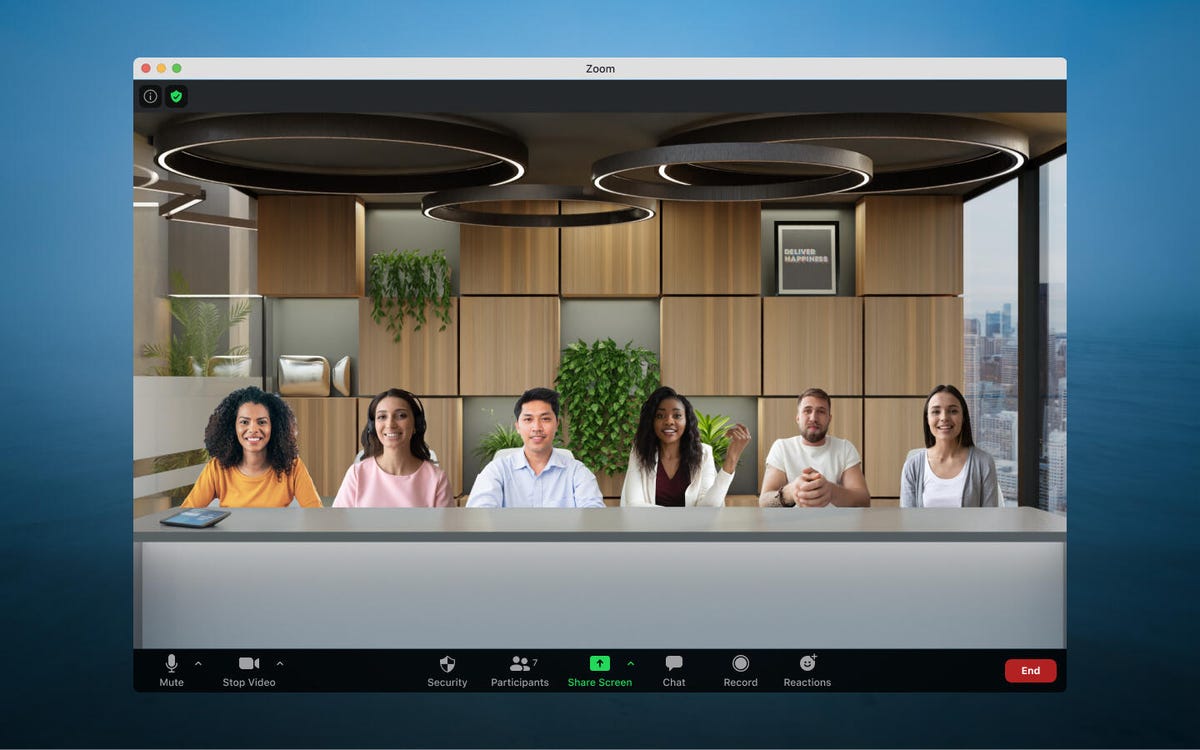
Try out Zoom’s immersive view feature to put yourself in the same virtual space as your fellow meeting participants.
Zoom’s immersive view feature lets you put yourself in the same virtual background as your fellow video chat participants — be it a conference room, classroom or anywhere else you can think of. If you’re the meeting or webinar host, start the Zoom meeting on your desktop (it will be enabled by default for all free and single pro accounts using Zoom 5.6.3 or higher). In the top right corner, where you find Speaker or Gallery View, you’ll see the option to enable Immersive View. Click Immersive View, and choose from one of Zoom’s provided scenes, or upload your own.
Your meeting participants or webinar hosts will now be placed in the same virtual background and will appear that way on every participant’s screen.
15. Hide nonvideo participants
On a larger call, your screen can get cluttered with participants, which can be distracting, especially if some don’t have their cameras on. Hide the participants who aren’t using video by going to Settings > Video > Meetings, and check Hide non-video participants. Now you’ll only be distracted by your co-workers’ pets and children who appear on video.
16. Use the vanishing pen to highlight without having to go back and erase
Zoom’s vanishing pen feature lets you highlight text as you share your screen.
Zoom’s vanishing pen feature lets you draw on your shared screen to call attention to text or objects, but then fades away so you don’t have to go back and erase your markings. To use it, share your screen, and click Annotate. On the menu that pops up, click Spotlight and click Vanishing Pen.
17. Record the meeting to your computer
Both free and paid Zoom subscribers can record their meeting to their laptop or computer using the desktop app (you can’t record on mobile at the moment, unless you have a paid account — keep reading for more on that). Those recorded files can then be uploaded to a file storage service such as Google Drive or Dropbox, or a video streaming service such as YouTube or Vimeo.
To enable local recording, go to Settings > Recording, and toggle it on. When you’re hosting a Zoom meeting, click the Record icon on the bottom toolbar.
18. Record a meeting to the cloud
If you have one of Zoom’s paid plans (which start at $149.90 for the year), you can make a recording that will save directly to the cloud (or to your computer if you prefer). To use this feature, click Record at the bottom of the meeting screen. You can pause or stop your recording at any time. Zoom will notify you when the recording is ready.
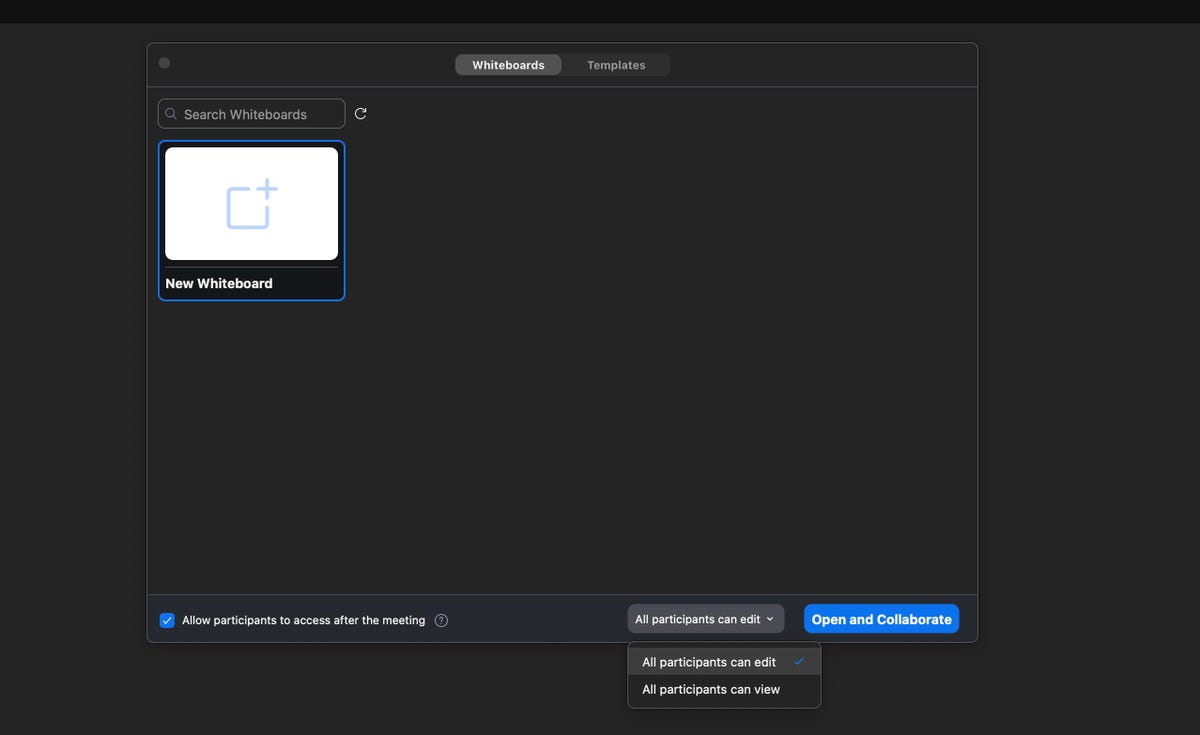
Here’s what it’ll look like when you start a new Whiteboard in Zoom.
19. Use the Whiteboard tool
The Whiteboard feature allows participants to collaborate on a sharable canvas that you can access even outside of meetings. To enable Whiteboard, make sure you’ve updated to the latest version of Zoom. Click Whiteboards in the bottom of the menu screen, choose New Whiteboard and click Open and Collaborate. You can choose if participants can view only or edit your board. Clicking Close Whiteboard will automatically save your Whiteboard for future use or viewing.
20. Host more than 100 people
If you have a group of more than 100 people to host for work or school, you have to upgrade to a paid professional account. If you upgrade to the highest tier (Enterprise Plus), you can host up to 1,000 participants.
21. Turn off or limit chat
Zoom’s chat feature is another great way to communicate with others in the meeting. If the chat is going off the rails and becoming a distraction, the meeting host can turn off chat, limit participants to only message the host or turn off chat completely. To do so, click the More dots in the chat side window and choose between No One, Hosts and Co-hosts or Everyone.
22. Turn on Live Transcript
To turn on captions during your Zoom meeting, click Live Captions at the bottom of the screen. From there, you can assign someone to type, use a third-party app or click Enable to use Zoom’s caption tool. Once you’ve turned on Live Transcript, you can repeat the previous steps and click View Full Transcript to read along with timestamps. Once the meeting is finished, you can click Save Transcript to keep a copy.
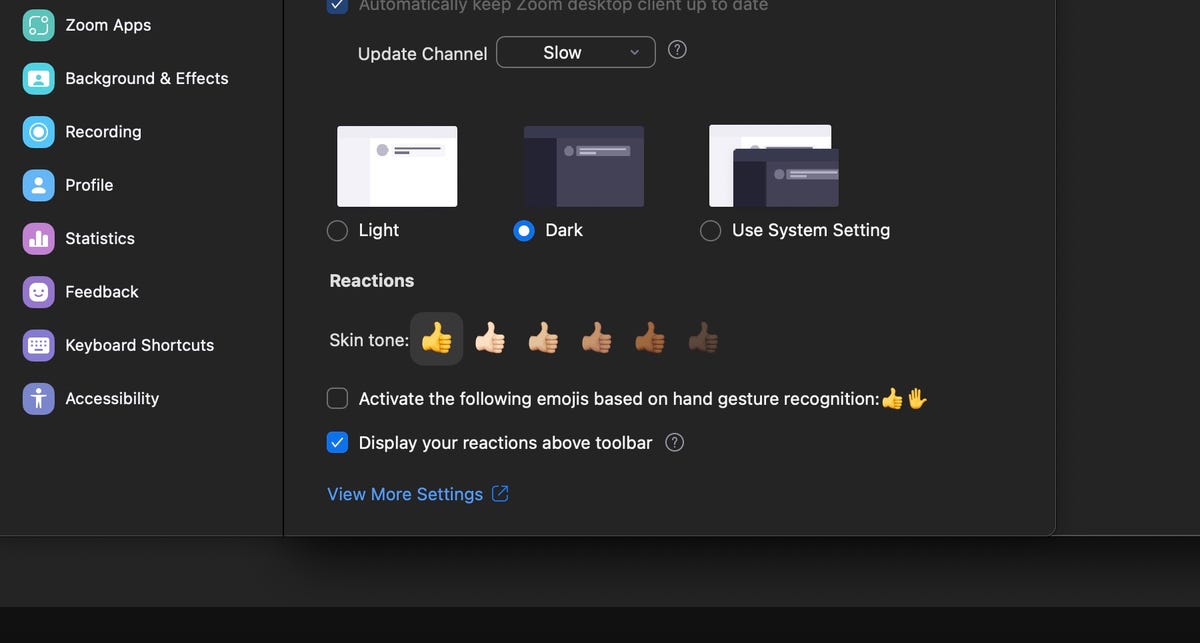
You can put Zoom into dark mode and change the skin tone of your emoji in the same place.
23. Turn on dark mode
Dark mode is a great way to save yourself from eye strain during a long work day. To turn on dark mode in Zoom, click your profile icon in the top right corner to open Settings. From there, choose between Light, Dark or Use System Setting.
Watch our video on how to make your webcam video look and sound great online and make sure to subscribe to the How to Do It All channel on YouTube for more how-to videos.
24. Change emoji reaction skin tones
By default, most emoji in Zoom are yellow, but you can customize them. Click your profile icon in the top right corner to open Settings. Under the options to change your Zoom settings to dark mode, you should see six thumbs-up emoji. Select the skin tone you want to use and the changes will save automatically. Now any hand emoji reaction you use during meetings will be the tone you chose.

You can choose from a number of animal avatars.
25. Use a fun avatar
If unique backgrounds aren’t enough fun, Zoom lets you use avatar filters during meetings. Go to Settings > Background & Effects and select Avatars. From there, you can choose from various animals to replace you in a meeting.
[ad_2]
Source link






